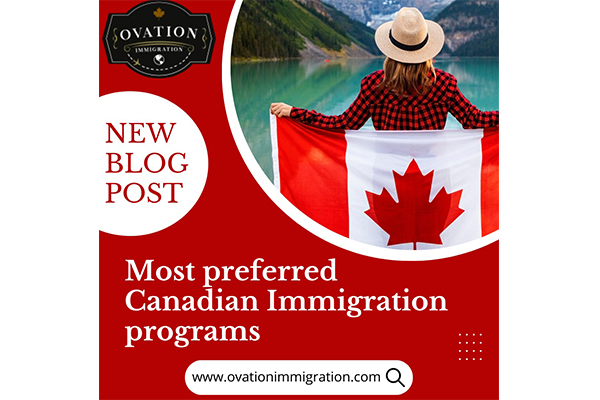Canada is considered one of the most immigrant-friendly nations across the globe. With over 1.2 million immigrants planning to migrate in the country, Canada is on the verge of bringing in a new wave of talent and ambition.
If you have been looking for ways to immigrate to Canada, here are a few programs that can work for you.
1. Federal Skilled Worker Program
The Federal Skilled Worker Program (FSW)is designed to bring more skilled human capital to Canada. The country’s recent slowdown in population growth is supported by an increased benchmark of immigration acceptance rate. Programs like the Federal Skilled Worker Program are one of the ways the Canadian government is allowing immigrants to migrate to the country to become Permanent Residents.
This program has minimum requirements for skilled work experience, language ability, and education. You must meet all the minimum requirements to be eligible.
There are several selection factors that are considered in a FSW application. You must meet all these minimum criteria to have your profile assessed under FSW:
- age
- education
- work experience
- whether you have a valid job offer
- English and/or French language skills
- adaptability (how well you’re likely to settle in Canada)
These factors are part of a 100-point grid used to assess eligibility for the Federal Skilled Worker Program. Points are given for each of these six factors. The current pass mark is 67 points.
The other comparable program is the Canadian Experience Class (CEC) which is for individuals with eligible Canadian work experience. FSW, on the other hand, does not have such a restriction. However, it mandates that the applicants must have had at least one year of full-time and continuous work experience under NOC skill level of A, B, or 0, in the last ten years. (Applicants must note that the NOC bifurcation is being redesigned across six levels and will go into effect in late 2022.)
The program has been one of the most preferred ways to enter Canada. However, Canada has not had an all-program express entry draw since September 2020. As the need for allowing immigrants grows in the country, applicants can expect a change in this situation.
2. Student Visa Program
Many of the applicants aiming to immigrate to Canada have the option of studying in the country’s post-secondary institutions in hopes of being part of the Canadian education system that promises high standards of education.
While many applicants are generally worried about the cost and the time taken to get permanent residency, the student visa route is one of the preferred programs because it gives students the chance to receive their higher education in Canada and gain Canadian work experience. Here are how applicants can structure their studies and work with the route:
- Right after secondary graduation, applicants can appear for IELTS academic exam. It is suggested that an individual receivesCLB7 in the four key sections (equivalent to IELTS 6 each), the applicant stands a good chance of entering Canada (with other factors also considered).
- The second step is to apply to an institution of your choice and receive admission.
- The next step is to apply for a study visa. The documents one needs to gather include but are not limited to:
- proof of acceptance
- proof of identity, and
- proof of financial support
- a letter of explanation
- a certificat d’acceptation du Québec (CAQ)
- If approval is granted on the study visa application, applicants can come to Canada and study in the program that they have enrolled in. If students commit to the conditions on their study permit, such as being enrolled in continuous post-secondary studies, students may be eligible to be awarded a post-graduate work permit (with other factors also considered). A PGWP allows them to work in Canada for up to three years from their graduation date. During the three years of post-graduate work permit, students can rack up enough CRS points to apply for permanent residence.
3. Provincial Nominee Programs
Provincial Nominee Programs are the Canadian government’s way to increase immigration in the provinces that need it the most. You can take this as a guiding thumb rule – provinces which are densely populated and have a flourishing economy, like British Columbia and Ontario, will usually have higher benchmarks for their PNPs.
Using the same logic, provinces like Labrador & Newfoundland or Prince Edward Island would have more accessible PNPs. Both ways, PNPs are becoming one of the most accessible routes to settle in Canada.
While provinces are the ones inviting applicants for permanent resident status, the PR process itself comes under federal jurisdiction. Hence, the provinces nominate eligible applicants for the next step in the process – getting approval from the federal body. With that in mind, applicants should focus on the PNP invite as a preliminary step in their route to getting a permanent residence.
On the surface, you might find several common properties between the different PNPs across Canada. However, trying to find the common ground between these PNPs would be a vanity exercise since most applicants apply only for a handful of PNPs which fit their prerogatives.
Our team has indexed the dedicated official page for each PNP run by each province across Canada to help you shorten your search process.
- Alberta Immigrant Nominee Program
- British Columbia Provincial Nominee Program
- Manitoba Provincial Nominee Program
- New Brunswick Provincial Nominee Program
- Newfoundland & Labrador Provincial Nominee Program
- Nova Scotia Nominee Program
- Ontario Immigrant Nominee Program
- Prince Edward Island Provincial Nominee Program
- Saskatchewan Immigrant Nominee Program
- Northwest Territories Nominee Program
- Yukon Nominee Program
How to Select the Right Program for Your Immigration Needs?
Canada offers over 80 immigration channels to build your future in the country. One wrong step in the documentation process can extend your application process by months or even years in some cases. This is the reason why it makes sense to work with a professional from day one of your immigration process.
Here is a logical approach you can take to structure your Canadian immigration process:
- Establish your goals: While everyone wants to stay and settle in Canada, you will have to be more specific about your goals. Define your budget, timeline, and career goals before you set out to immigrate. This will help you filter alternatives very quickly.
- Find the right immigration consultant: Finding the right consultant is a crucial part of the process. A licensed consultant with expertise in immigration programs will be able to assess your profile and assist you in shortlisting the right programs best fit to your profile which will substantially increase your chances of success.
Connect with our team of professionals for a free consultation session.




